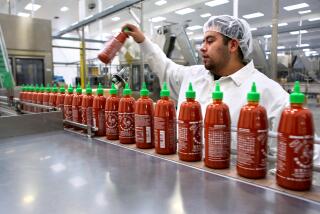Argentina farmers hit hard by worst drought in decades
- Share via
STROEDER, ARGENTINA — Skeletons of livestock are piling up in the scorching sun of the Southern Hemisphere’s summer as the worst drought in a generation turns much of Argentina’s breadbasket into a dust bowl.
The nation’s farm sector stands to lose $5 billion this year -- a huge blow to the economy of Argentina, a top world exporter of soy, corn, wheat and beef -- as well as to the government of President Cristina Fernandez de Kirchner, which faces billions of dollars in debt payments.
Wheat fields that once supplied flour for pasta-loving Argentines now resemble deserts, and spiny thistles are all that survive on cattle ranches in southern Buenos Aires province.
Nothing edible grows, said Hilda Schneider, a 65-year-old rancher who has lost nearly 500 cows to starvation.
“With the situation we’re in now, without any harvest, there’s nothing to do,” said Schneider, one of 2,000 residents in Stroeder, a farming village suffering its worst drought since the 1930s. “We try to save the animals, which is the only thing we have left.”
Nationally, there hasn’t been this little rain in Argentina since 1971, according to Liliana Nunez of the National Weather Service.
She said ocean temperatures in the Southern Atlantic have fueled wind currents that have prevented colder, wetter Pacific fronts from moving in and forming rain clouds over much of Argentina, Paraguay, Uruguay and southwestern Brazil.
Other soy growing areas across the region are expecting crop losses. Uruguay has declared a farming emergency. But Argentina seems hardest hit overall, with the Agriculture Secretariat projecting a 44% drop in the 2008-2009 wheat harvest, and a 27% drop in corn. Argentine harvests of more resilient soy are expected to increase by just 7% after rising an average of 10% per year since 2003.
The farming sector could lose $5 billion this year, and the government could lose $4.3 billion in tax revenue from the agricultural sector, said Milagros Gismondi, an analyst with the economic consultancy Orlando J. Ferreres y Asociados in Buenos Aires.
How Fernandez responds to the drought could have a big impact on this year’s midterm elections. Her political clout suffered last year when strikes by farmers and truckers forced her to reverse the tariff hikes on grain exports that her government imposed when prices were soaring.
Now some Argentine provinces have declared agricultural emergencies -- a move Fernandez has resisted nationally because it would mean canceling or suspending more taxes. But her government has reduced export tariffs on wheat, corn, fruits and vegetables in recent weeks in the face of slumping commodity prices, and temporarily suspended the minimum weight for slaughtering livestock so that ranchers can sell cattle before they starve.
The government also released $66 million in subsidies to small agricultural producers; qualifying farmers in Stroeder will get about $4,500 each. Many said that wouldn’t even cover diesel for their tractors.
Elbio Madarieta’s once-fertile 12,000-acre ranch outside Stroeder is now an arid plain, scattered with the remains of the 900 cattle he lost last year -- 25% of his herd. The wind kicks up of clouds of dust, and not a stalk of wheat can be seen, let alone anything green for grazing.
The 56-year-old farmer and agronomist figures it will take five years after rains return for the soil to recuperate lost moisture and nutrients. Until then, Madarieta will have to sell the cows that he has managed to keep alive on costly feed. And restoring the herd won’t be easy, since malnourished cows are less likely to reproduce.
Farm labor leaders have begun pressing for government stimulus.
“The declaration of a national disaster is fundamental,” said Javier Jayo Ordoqui, leader of the Argentine Rural Confederation. “Where is the government’s plan for financing the next planting?”
“We’re working on it, redistributing money to assist in the emergency,” Agriculture Secretary Carlos Cheppi said last week. He said the $66 million has already been sent to provincial governments for distribution to farmers.
Vittorio Vavrin, 78, said the last harvest on his medium-sized wheat farm was a bust, and he’s already given up on the next one.
“You can’t keep working with the lack of rain and the price of seed,” said Vavrin, his eyes trained on the dry ground. “I went into debt, the harvests shrank, costs increased. I took out loans and I couldn’t pay them.”
More to Read
Sign up for Essential California
The most important California stories and recommendations in your inbox every morning.
You may occasionally receive promotional content from the Los Angeles Times.













